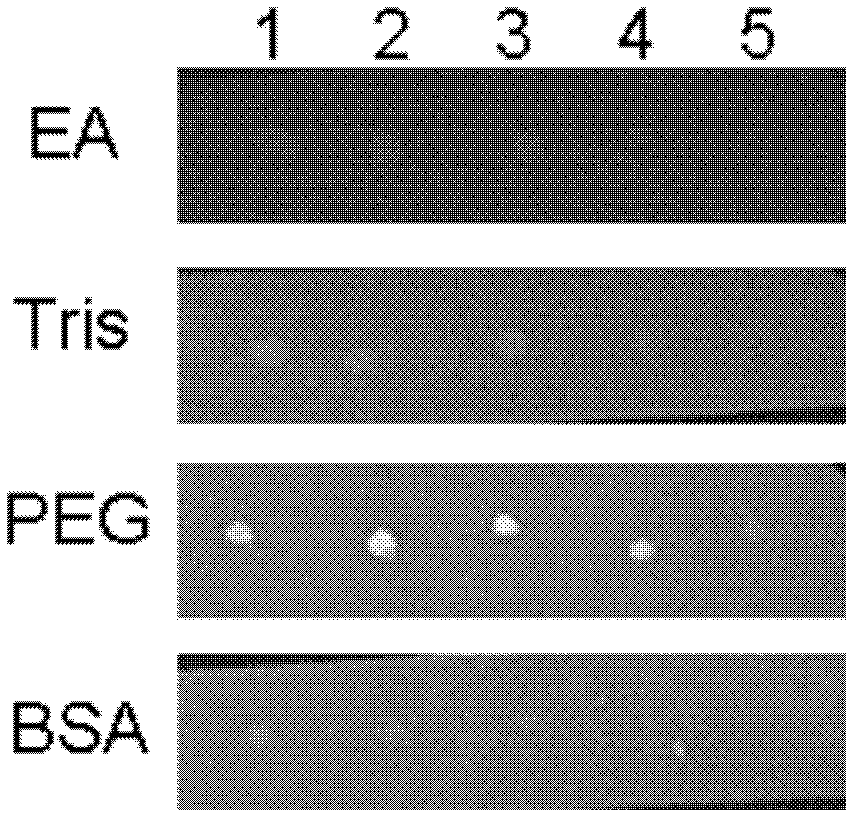Method for utilizing covalence coupling to prepare photon point-antibody compound
An antibody complex and covalent coupling technology, which can be used in measurement devices, instruments, scientific instruments, etc., can solve the problems of easy precipitation and false positives in immunodetection, and achieves simple and easy method, improved colloid stability, The effect of improving immune properties
- Summary
- Abstract
- Description
- Claims
- Application Information
AI Technical Summary
Problems solved by technology
Method used
Image
Examples
Embodiment 1
[0026] Preparation of quantum dots:
[0027] (1) Mix 1 mmol of cadmium oxide, 4 mmol of stearic acid and 10 milliliters of liquid paraffin, then heat to 200° C. under nitrogen protection until the cadmium oxide is completely dissolved; then the system is cooled to room temperature, and 10 milliliters of liquid paraffin, 1 gram of trioctylphosphine oxide and 3 grams of octadecylamine were heated to 300°C under nitrogen protection; 4 millimoles of selenium powder was dissolved in 5ml of liquid paraffin and 1ml of trioctylphosphine, and quickly injected into the above cadmium solution, the reaction After 30 minutes, CdSe quantum dots with a particle size of about 4 nanometers were obtained;
[0028] (2) At 250°C, add 2ml of 0.1mM zinc stearate paraffin solution to the CdSe quantum dot system prepared in step (1), react for 10min, then add 2ml of 0.1mM sulfur powder paraffin solution, and react for 10min; Repeat above-mentioned steps (namely add the reaction of zinc stearate para...
Embodiment 2
[0032] Preparation of quantum dots:
[0033] (1) 0.68 grams of cadmium chloride and 1.20 grams of glutathione were dissolved in 5 milliliters of deionized water, adjusted to alkaline (pH=10.0);
[0034] (2) Mix 0.08 gram of selenium powder and 0.39 gram of sodium borohydride, inject 5 ml of deionized water, react for 30 minutes, and obtain sodium selenium hydride solution;
[0035] (3) The solutions obtained in steps (1)-(2) were mixed, sealed in a reaction kettle under nitrogen protection, and heated at 140° C. for 60 minutes to obtain CdTe water-soluble quantum dots with a particle size of about 5 nanometers.
[0036] Disperse 5 nanomoles of the CdTe quantum dots (particle size about 5 nanometers) synthesized by the surface with carboxyl groups prepared above in 1 ml of 100 mM phosphate buffer (pH 7.4), and then add 0.25 micromoles of EDC and 0.25 micromoles of NHS Micromole, then at room temperature, incubated on a shaker for 2 hours to activate the carboxyl groups on the ...
Embodiment 3
[0038] Preparation of quantum dots:
[0039] (1) Mix 1 mmol of cadmium oxide, 4 mmol of stearic acid and 10 milliliters of liquid paraffin, then heat to 200° C. under nitrogen protection until the cadmium oxide is completely dissolved; then the system is cooled to room temperature, and 10 milliliters of liquid paraffin, 1 gram of trioctylphosphine oxide and 3 grams of octadecylamine were heated to 300°C under nitrogen protection; 4 millimoles of selenium powder was dissolved in 5ml of liquid paraffin and 1ml of trioctylphosphine, and quickly injected into the above cadmium solution, the reaction After 30 minutes, CdSe quantum dots with a particle size of about 4 nanometers were obtained.
[0040] (2) At 250° C., add 2 ml of 0.1 mM zinc stearate paraffin solution to the CdSe quantum dot system prepared in step (1), react for 10 min, then add 2 ml of 0.1 mM selenium powder paraffin solution, and react for 10 min; Repeat above-mentioned steps (namely add the reaction of zinc ste...
PUM
| Property | Measurement | Unit |
|---|---|---|
| Particle size | aaaaa | aaaaa |
| Particle size | aaaaa | aaaaa |
Abstract
Description
Claims
Application Information
 Login to View More
Login to View More - R&D
- Intellectual Property
- Life Sciences
- Materials
- Tech Scout
- Unparalleled Data Quality
- Higher Quality Content
- 60% Fewer Hallucinations
Browse by: Latest US Patents, China's latest patents, Technical Efficacy Thesaurus, Application Domain, Technology Topic, Popular Technical Reports.
© 2025 PatSnap. All rights reserved.Legal|Privacy policy|Modern Slavery Act Transparency Statement|Sitemap|About US| Contact US: help@patsnap.com


